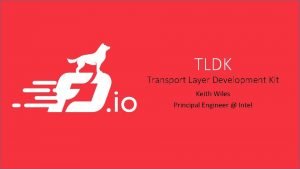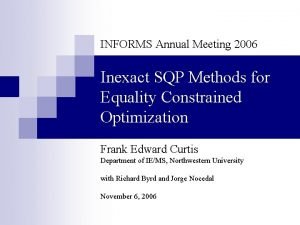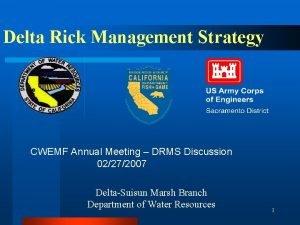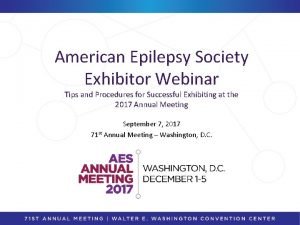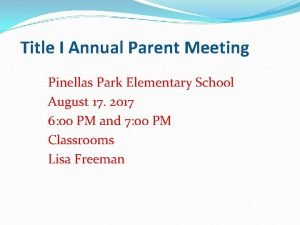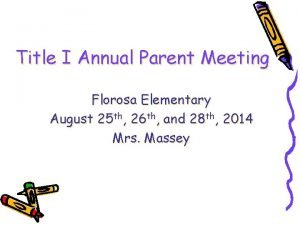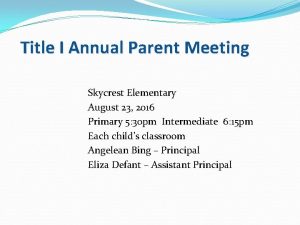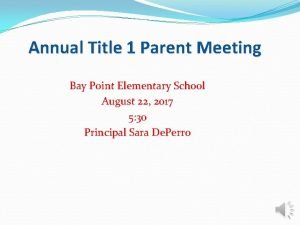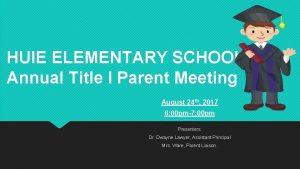Title I Annual Parent Meeting Wiles Elementary Katherine



















- Slides: 19

Title I Annual Parent Meeting Wiles Elementary Katherine Munn-Principal Ed Haukland-AP

Agenda • • • Welcome and Introductions All About Title I Budgets Standards and Testing Title I Beginning of School Packet Our Home-School Compact Our School’s Parent & Family Engagement Plan Keys to Your Child’s Success Parent Input Evaluation

What is Title I? • Title I is the major component of the Elementary and Secondary Education Act (ESEA) and the largest federal assistance program for our nation’s schools. • The goal of Title I is a higher quality of education for every child. • The program serves millions of children in elementary and secondary schools each year.

How Title I Works? • Title I funding flows from the U. S. Department of Education (as appropriated by Congress) to the Florida Department of Education (FLDOE). • The FDOE allocates funds to the District. • The District identifies eligible schools and allocates Title I funding to those schools based on the number of Children from Low-Income Families (CLIF). • Title I schools spend the funds allocated based on formalized School Improvement Plans approved by District and FLDOE. • Our School implements a Targeted Assisted program.

Title I Funds Provide Supplemental Support Our School’s Title I funds provide the following supplemental support: • Additional Personnel to support our students and teachers • Additional classroom materials and equipment • Technology • Supplemental web-based programs: Achieve 3000 and Reflex Math • Supplemental curriculum • Small group intervention • After school tutoring • Additional Professional Development Title I funds also provide for Parent-Family Engagement activities and trainings throughout the year as well as: • Resources in our Parent & Family Resource Area • Student Planners and/or Home-School Communication Folders

Who decides how funds are used? • The school’s leadership makes personnel and instructional decisions based on the specific needs of its student population. • Parent input into the decision making process is encouraged through various means including: ❖ School Advisory Council (SAC) composed of Parents, Community members, Teachers, Other staff that works at the school, Principal and Students (at Middle and High School) ❖ Parent input meetings for the development of the Home-School Compact and the school’s Parent-Family Engagement Plan ❖ Input Evaluations of Parent-Family Engagement activities and trainings

Where can I find a copy of the Title I Budgets? The Title I Budgets, including Part A Basic and Parent & Family Engagement must be discussed with parents and documented by minutes from this Title I Annual Parent Meeting. A copy of the school’s Title I Budgets (Part A Basic/PFE) must be in the Parent & Family Resource Area Notebook located in Media Center.

Educational Standards Florida’s academic content standards establish high expectations for all students. Florida State Standards and Next Generation Sunshine State Standards will identify what your child needs to know and be able to do in all content areas at each grade level. Information located at: www. fldoe. org/bii/curriculum/sss/

School’s Curriculum The Florida Standards form the framework student knowledge in: • English Language Arts (ELA) ❖ Reading/Writing/Speaking & Listening/Language • Mathematics • Literacy in Social Studies Next Generation Sunshine State Standards form the framework for science.

Measuring student success through District Progress Monitoring The District monitors student progress through a variety of assessments. Baseline assessment are given to determine the student beginning level of understanding as various educational standards. Interim Progress monitoring is used to track how well students are understanding and applying new skills. Quarterly Progress Monitoring is used to measure the student’s current level of proficiency on specific Florida Standards. Below is a chart outline the Alachua County Progress Monitoring cycle for 2020 -2021. Subject Grade Level/ Course Baseline Assessment ELA Elementary K 1 2 -5 FLKRS ISIP ELA Secondary 6 -10 Baseline Test in Mentoring Minds Math Elementary K-5 Interim Progress Monitoring Quarterly Progress Monitoring DIBELS AIMS ISIP 1 Mini AIMS 2 Half AIMS 2 Math Secondary 6 -8 Math/Accelerated Algebra 1/Honors Geometry/Honors Liberal Arts Math Informal Geometry Baseline Test in Mentoring Minds Mini AIMS 2 AIMS Science Elementary 3 -5 N/A 6 N/A 7, 8, Biology N/A Civics, U. S. History N/A Science Secondary Social Studies Unit Tests from Basal Curriculum 3 Mini AIMS 2 AIMS Half AIMS AIMS

Florida Standards Assessment Grades 3 -10 Students are tested on: ❖ FSA English Language Arts: grades 3 -10 ❖ ❖ *FSA Writing Component included in ELA: grades 4 - 10 FSA Mathematics Grade 3 -8 SSA Science: Grades 5 and 8. Secondary students take the following End-of Course Assessments: ❖ Civics ❖ US History ❖ Biology ❖ Algebra I ❖ Geometry

Working together! • The ESSA law requires that all Title I schools and families work together. • How we work together is listed in our Beginning of School Packet: ❖ District Parent-Family Engagement Plan ❖ School Level Parent & Family Involvement Plan ❖ Home-School Compact ✔ Which will be discussed with you during classroom visitation and Parent-Teacher Conferences ❖ School Wide Improvement Plan (SWIP) This information packet is sent home to all families by each Title I school via your student’s backpack or electronically for Digital Academy families. They can be found in the Parent & Family Resource Area Notebook as well as on the school’s website.

Parents’ Right to Know It is your right to: • Be involved and request regular meetings to express your opinions and concerns • Be provided information on your child’s level of achievement on state assessments in reading/language arts, writing, mathematics, and science • Request and receive information on the qualifications of your child’s teacher • Be informed if your child is taught by a Non-Certified Teacher four or more consecutive weeks

Parent & Family Engagement Plan Guidelines • • As a parent or family member you are vital in the development, implementation, and review of the parental and family engagement program at our school. So that you can be as active as possible in your child’s school success we will: ❖ Convene this Annual Meeting to inform you of Title I program requirements and your rights to be informed and involved regarding this program. ❖ Provide families with timely information regarding Parent & Family Engagement Activities and Trainings. ❖ Offer activities and trainings at flexible times and through a variety of formats to maximize participation. ❖ Assist families in understanding academic content standards, assessments, and how to monitor and improve the achievement of their children. ❖ Provide materials and training to help you work with your child to improve his or her achievement. ❖ Inform you on where to locate a copy of the Title I Complaint Procedures.

Parent & Family Resource Area • An area/room has been established to house resource materials for parents and families to access as needed. • This area/room contains a variety of informational and academic materials for parents to take and use with their student at home. • Our Parent & Family Resource Area is located in Media Center.

Your Involvement is Key to Your Child’s Success! • You are your child’s first teacher. • You have the ability to influence your child’s education more than any teacher or school. • You know your child best: ❖ Share information about your child’s interests and abilities with teachers ❖ Ask to see FSA results, AIMS, DIBELS (K-1), and ISIP results, as well as Progress reports ❖ Discuss these results with your child’s teacher so that you understand how to help your child at home ❖ Be knowledgeable of grade level expectations

Additional Information Teachers will provide specific information on: • • • Florida Standards Assessment Next Generation State Standards Grade Level Expectations Grade Specific Curriculum Measuring Student Success Definition of Proficiency Overview of their plans for the year Review the Home-School Compact Home-School Communication Systems

Questions?

Thank you for attending. Be sure to review and sign: ❑Title I Annual Meeting Evaluation Form ❑The Title I Parents’ Rights Letter ❑Home – School Compact � For families attending virtually, look for an email containing the documents above as Google Forms
 Wiles elementary
Wiles elementary Tldk
Tldk Martin wiles
Martin wiles Rose wiles
Rose wiles Louise wiles
Louise wiles Wiles miracles
Wiles miracles Informs annual meeting
Informs annual meeting Annual theory meeting
Annual theory meeting Scts annual meeting
Scts annual meeting Aashto annual meeting 2015
Aashto annual meeting 2015 Aupha annual meeting
Aupha annual meeting Cwemf annual meeting
Cwemf annual meeting Nrg oncology meeting 2016
Nrg oncology meeting 2016 American psychiatric association annual meeting 2020
American psychiatric association annual meeting 2020 How to run an annual general meeting
How to run an annual general meeting American epilepsy society annual meeting 2017
American epilepsy society annual meeting 2017 Grand lodge of kentucky
Grand lodge of kentucky Nrg oncology semiannual meeting
Nrg oncology semiannual meeting Prior lake wrestling schedule
Prior lake wrestling schedule Bob gecewich
Bob gecewich

